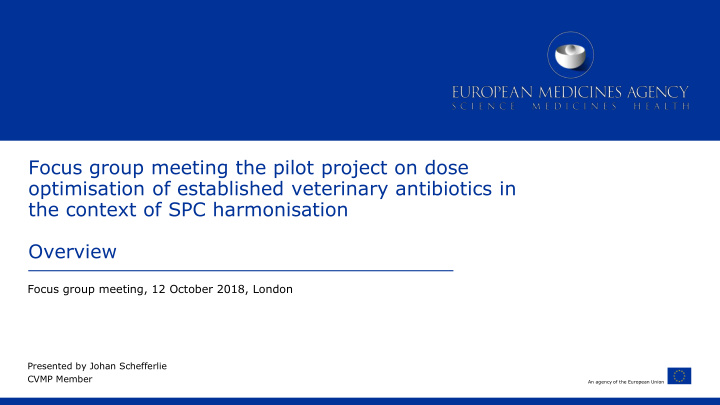



Focus group meeting the pilot project on dose optimisation of established veterinary antibiotics in the context of SPC harmonisation Overview Focus group meeting, 12 October 2018, London Presented by Johan Schefferlie CVMP Member An agency of the European Union
Today’s goals Understanding of the Reflection Paper Immediate comments from external interested parties – exchange of views Ideas for improvement of the methodology Ideas for future implementation 1 Overview
Intention of the Reflection Paper The RP is not a guideline The RP provides a set of tools (developed in a pilot project) These tools may or may not be used in the future (e.g. in harmonisation procedures) 2 Overview
Background Maintaining MAs for “old” antibiotics is vital Authorised posology is not always adequate today Right dose, the right withdrawal period, and the right warnings on the label: Shared Industry/Regulator responsibility Dose optimisation via additional experimental data unrealistic in current regulatory environment Pilot Project (input from regulators and industry): exploring and testing non- experimental approaches 3 Overview
Content of the Reflection Paper Explanation and aim Selection and prioritisation of candidate products for dose optimisation Collection and use of data Description of methodologies: - dose optimisation by PK/PD integration - establishment of the withdrawal period by PK modelling - addressing risks for the environment and target animals by data review approach Case studies (as examples – not the final answer) Discussion and conclusions CVMP Recommendations 4 Overview
Selection and prioritisation of candidate products for dose optimisation Selection The existence of different dosage recommendations for the products in the SPCs, • – within a product between MSs; different doses within a product from the same MAH are a clear indicator of the need to optimise the dose. – or between similar products without obvious reasons (such as differences in formulation) evidence of lack of efficacy from pharmacovigilance data, formularies, literature • evidence of decreased susceptibility or increased resistance of target pathogens • 5 Overview
Selection and prioritisation of candidate products for dose optimisation Prioritisation 6 Overview
Collection and use of data Data are collected at the animal species-disease indication-route of administration- pharmaceutical form level Data can be obtained from MA dossiers, literature, published ARs, … Data are integrated to allow the optimal selection of the parameters for the dose- and WP-modelling and to allow a complete data review for TAS and ERA - the use of MA-dossier data across a range of products is already possible under an article 35 referral Harmonisation at individual product level 7 Overview
Collection and use of data 8 Overview
CVMP recommendations 1. It is recommended that there is a continued dialogue between regulators and industry to discuss the possible procedures and legal implications in relation to the implementation of the recommendations of this report. 2. It is recommended that the implementation of the recommendations of this report will take place at the central level, i.e. that CVMP will conduct the scientific assessment. It was noted that the outcome could result in an e.g. Commission Decision. 9 Overview
CVMP recommendations 3. It is recommended to develop a clear procedure to establish a list of the candidate products for dose optimisation, with a prioritisation of these candidates, in line with the principles discussed in chapter 2 of this report. In establishing the actual list, it is recommended that relevant stakeholders are consulted. For example, the FVE can be consulted to obtain information of dosages used in the field, and VetCAST can be consulted to obtain information products for which, according to their knowledge, the current dosing regimens is not in line with PK/PD principles. 10 Overview
CVMP recommendations 4. It is recommended that selected candidate products for dose optimisation are grouped at the animal-species-disease-route of administration-pharmaceutical form level. 5. It is recommended to follow the hour glass approach (see chapter 2) for collection and integration of data and for the application of model outputs. 6. It is recommended that procedures for dose optimisation, withdrawal periods, ERA, and TAS, result in harmonisation at product level and where applicable also between similar products as outlined in paragraph 9.5.2.2 7. It is recommended that the dose optimisation and the consideration of withdrawal period, ERA, and TAS, are conducted in accordance with the principles presented in chapters 3, 4, 5, and 6 of this report. 11 Overview
Future perspective Implementation: How, when, who? • As part of the harmonisation in accordance with article 70 of the new Regulation?? – Procedures are governed by the CMD-v – Prioritise “…taking into account the recommendations of the Agency on class or group of reference veterinary medicinal products that shall be harmonised in order to protect human or animal health or the environment, including mitigation measures to prevent the risk to the environment.” – Can the Agency be consulted during this procedure?? – What are the possibilities for influencing timing and prioritisation?? 12 Overview
Future perspective • Following Community Interest Referrals, e.g. triggered by the Commission?? – Low predictability in relation to if, when, what products… • Regulators/Industry agreed scheme?? – Possible at all? – Community Interest Referral to be used? – Better influence on timing and prioritisation – How to stay ahead of the harmonisation procedures? 13 Overview
Thank you for your attention Further information zoltan.kunsagi@ema.europa.eu European Medicines Agency 30 Churchill Place • Canary Wharf • London E14 5EU • United Kingdom Telephone +44 (0)20 3660 6000 Facsimile +44 (0)20 3660 5555 Send a question via our website www.ema.europa.eu/contact Follow us on @EMA_News
Recommend
More recommend